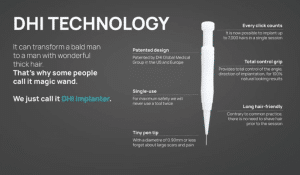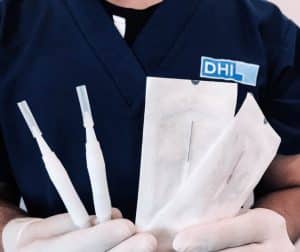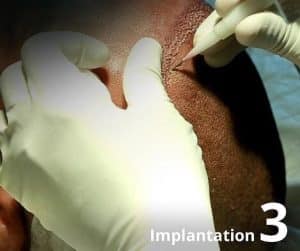The Role of Advanced Implanters in DHI Hair Transplant Procedures
Hair loss is a growing concern for both men and women due to genetics, stress, lifestyle factors, or environmental changes. Among the many solutions available, hair transplantation remains one of the most reliable methods to restore natural-looking hair. And when it comes to hair restoration, Direct Hair Implantation (DHI™) stands out as one of the most advanced and effective techniques—thanks largely to the use of Advanced Implanters.

What is the DHI Hair Transplant Procedure?
DIRECT HAIR IMPLANTATION (DHI) – DHI is a unique hair transplant procedure that can only be performed by:
- DHITM Technique
- DHI-certified doctors
- DHI protocols
- DHI’s patented instruments
- At DHI authorized clinics
No pain, no scars, no downtime. Perfect natural result every single time.
What Makes DHI™ Different?
At DHI India, every hair transplant is performed using single-use, disposable punches and needles, which are destroyed in front of the patient after the session to ensure complete hygiene and transparency. The procedure is minimally invasive, highly precise, and performed under strict medical protocols by certified doctors trained by the London Hair Restoration Training Academy (LHRTA).
What Is an Advanced Implanter?
An Advanced Implanter is a specialized tool used in the DHI™ procedure to implant hair follicles directly into the scalp. It features a hollow needle tip that securely holds individual grafts and enables implantation at the correct angle, depth, and direction—essential for natural-looking results.
This tool is central to what makes DHI™ unique. Unlike traditional hair transplant methods, which often require creating recipient channels before implantation, the DHI™ technique allows direct implantation without prior incisions, making the procedure less invasive, faster, and more accurate.

How the DHI™ Hair Transplant Procedure Works
The DHI™ procedure follows a three-step process:
Step 1: Graft Extraction
The doctor applies local anesthesia to the donor area, typically the back of the scalp, and carefully extracts hair follicles using a DHI™ extractor.
Step 2: Graft Preparation
Technicians sort the grafts into single, double, and triple hair units. These are then loaded into the Advanced Implanter using forceps, ensuring precision in angle, depth, and direction for each implant.
Step 3: Direct Implantation
The doctor implants the hair follicles directly into the recipient area using the Advanced Implanter. The tools come in multiple sizes to suit different graft types and hair loss patterns, making the process faster and more efficient. Additionally, the advanced implanter increases the grafts’ survival rate, minimizes damage to the surrounding tissues, and offers quick recovery. DHI implanters have no side effects; they can provide excellent results if professionals appropriately use these tools.

Key Benefits of Using Advanced Implanters in DHI™
- Precise Implantation Between Existing Hair
DHI™ implanters allow for hair graft placement without shaving the existing hair. This is especially helpful for patients who want to maintain their current hairstyle during the transplant.
- Correct Angle, Depth, and Direction
Implanters help replicate the natural hair growth pattern by maintaining a consistent implantation angle and depth, essential for a realistic, natural result.
- Higher Density, Less Trauma
Since there’s no need to create channels before implantation, the Advanced Implanter allows for denser graft placement while reducing trauma to the scalp. This results in minimal bleeding, reduced pain, and faster healing.
- Higher Graft Survival Rate
By minimizing handling and exposure time, the Advanced Implanter increases graft survival rates, leading to better long-term hair growth and improved outcomes.
Quick Recovery with DHI
DHI™ hair transplant recovery is relatively quick. Patients are usually discharged the same day and can resume daily activities within two days. The use of implanters makes the procedure virtually painless, and most patients report minimal discomfort during recovery. However, it’s essential to follow the post-care instructions provided by the surgeon to ensure the best results.
Who Is a Good Candidate for DHI?
DHI™ is ideal for individuals with healthy donor hair who are looking to restore hair in areas such as the scalp, eyebrows, beard, or mustache. However, a consultation is necessary to assess overall health, hair loss severity, and to develop a personalized treatment plan. During this consultation, the doctor will determine the number of grafts required and estimate the cost accordingly.
Why Choose DHI International and India?
At DHI™ International and India hair transplant clinics, we follow strict international protocols, use 100% safe and sterile equipment, and have a graft viability rate of over 97%. Our surgeons are certified professionals, and each transplant is performed using Advanced Implanters, ensuring maximum precision and natural-looking results.
Rediscover Your Confidence with DHI
When it comes to natural, safe, and permanent hair restoration, the Direct Hair Implantation™ technique with Advanced Implanters is the gold standard. Trust the experts at DHI™ India to help you regain your hair, your hairline, and your confidence.
7 Key questions you should ask before choosing your hair loss solution
1) Who will perform the procedure?
In most clinics, procedures are performed by technicians only. The clinic owners are plastic surgeons and dermatologists, mainly involved in sales and marketing. Their involvement in the actual procedure is minimal. It would be best to go to a clinic where a doctor performs the entire procedure themselves, not through a technician.
It is also important to check if the clinic or doctor specializes in hair transplants or offers other aesthetic treatments, such as Botox. A better choice would be to go for a super specialist doctor.
2) Is your doctor suitably trained and certified? Do they follow standard and accredited protocols?
Doctors often learn about hair transplants from other doctors without any evaluation or certification process. It can take years for them to understand the intricacies of hair transplants. Further, most doctors do not follow written protocols and perform procedures based on personal preferences, leading to sub-optimal results.
Please check if the doctor performing the procedure has training and accreditation from a reputed institute. Very importantly, personally verify if the clinic has written protocols for all stages of the hair transplant procedure, including detailed safety protocols.
3) What is the experience of the clinic/doctor you are going to?
Hair transplants are a relatively new area of practice, which has lured many doctors to leave their practice in the field of their expertise and move towards hair transplants only in the last 3-5 years. Many clinics may not have the experience, protocols, or necessary expertise to handle hair transplant cases. Please ensure that the clinic has been established for many years and has a verifiable reputation. Do not just rely on what they claim.
4) How does the clinic ensure the quality of your results?
Research shows that, on average, only half of the implanted hair may grow in specific clinics without proper experience. The clinic may not have access to the latest techniques, instruments, tools, protocols, etc. Please avoid freelancers working in many clinics on a case-by-case basis. They will likely spoil your case as they may care least for the patient. Sometimes, the doctor may be very qualified or experienced but past his prime to be able to give good results.
Do check if someone supervises the doctor’s work. Does the doctor follow any certification, assessment, and quality monitoring process? It is not advised to go to a clinic where there is only one doctor whose work goes unsupervised.
Proper technique, instruments, tools, protocols, training, assessment, and quality control are essential for good results.
5) How do you ensure your safety during and after the hair transplant procedure?
Generally, hair transplants are safe and do not lead to severe risks. However, scalp infections or even more severe conditions could occur if the correct safety protocols are not followed. This risk is very high when technicians or inexperienced doctors perform the procedure.
You are advised to ask relevant questions and follow the written safety protocols at the clinic. Please see the procedure room and ask yourself if you feel confident about the safety protocols.
6) Would you go for a hair transplant without a proper evaluation of your alopecia?
The answer is obviously No. There are ten kinds of alopecia. The correct treatment cannot be recommended unless a proper diagnosis is made. Many clinics recommend hair transplants without making a proper diagnosis. They also may not conduct a mathematical count of the donor and recipient areas to correctly assess the hair transplant requirement and feasibility. Please invest time and effort during your diagnosis and evaluate the doctor on proper dermatological examination, diagnosis, precise donor and recipient area hair count, and computerized alopecia test. This results in a comprehensive lifetime treatment plan and the best results for your hair loss problem.
7) Should price play a role in choosing a hair transplant clinic or doctor?
Yes, of course, price is indeed a very important criterion. But you should not choose a clinic or doctor purely on the cost. Many doctors can reduce their costs significantly by reusing the instruments, compromising on safety standards, using technicians to do the procedures, etc. Quality and Safety come at a price. This is your investment in your safety and great-looking results for life. So, choose wisely.




